Measurement of Shoulder Abduction Angle with Posture Estimation Artificial Intelligence Model
Abstract
1. Introduction
2. Materials and Methods
2.1. Participants
2.2. Goniometric Measurements
2.3. Data Acquisition and Image Processing by MediaPipe
2.4. Machine Learning (ML)
2.5. Parameters
- rtarm_distratio: The ratio of the length between the right shoulder and right elbow to that between the right shoulder and right hip joint (Figure 7: ①/②), representing the relative positional relationship of the elbow with respect to the shoulder and hip joints.
- rtelbowhip_distratio: The ratio of the length between the right elbow and the right hip joint to that between the right shoulder to the right hip joint (Figure 7: ③/②), reflecting the relative positional relationship of the elbow and hip joints with respect to the shoulder.
- rthip_distratio: The ratio of the length between the right shoulder and the right hip joint to that between the hip joints (Figure 7: ④/②), representing the relative positional relationship of the waist with respect to the shoulder.
- rtshoulder_distratio: The ratio of the length between the shoulder joints to that between the right shoulder and right hip joint (Figure 7: ⑤/②), clarifying the relative positional relationship of the shoulder with respect to the hip joint.
- rtshoulder abduction: Calculate angle ⑥ in Figure 7 from the 2D coordinates to represent the abduction angle of the right shoulder in the 2D space.
- rtshoulder_3Dabduction: Calculate angle ⑥ in Figure 7 from 3D coordinates to represent the abduction angle of the right shoulder in the 3D space.
- rtshoulderAngle: Calculate the angle ⑦ in Figure 7 from 2D coordinates to represent the angle between the right shoulder, right elbow, and right waist in the 2D space.
- rtshoulder_3Dangle: Calculate the angle ⑦ in Figure 7 from 3D coordinates to represent the angle between the right shoulder, right elbow, and right waist in the 3D space.
- rt_uppertrunkAngle: Calculate angle ⑧ in Figure 7 from 2D coordinates to represent the angle between the right shoulder, upper trunk, and left shoulder in the 2D space.
- lt_uppertrunkAngle: Calculate angle ⑨ in Figure 7 from 2D coordinates to represent the angle between the left shoulder, upper trunk, and right shoulder in the 2D space.
- rt_lowertrunkAngle: Calculate angle ⑩ in Figure 7 from 2D coordinates to represent the angle between the right waist, lower trunk, and left waist in the 2D space.
- lt_lowertrunkAngle: Calculate angle ⑪ in Figure 7 from 2D coordinates to represent the angle between the left waist, lower trunk, and right waist in the 2D space.
- rt_faceAngle: Calculate angle ⑫ in Figure 7 from 2D coordinates to represent the angle between the right side, center, and left side of the face in the 2D space.
- lt_faceAngle: Calculate angle ⑬ in Figure 7 from 2D coordinates to represent the angle between the left side, center, and right side of the face in the 2D space.
- rt_trunksize: As portrayed in Figure 7, calculate the magnitude of the cross-product of the vector from the right shoulder to the left shoulder () and the vector of the length of the right trunk (), divided by the square of the right trunk length, representing the relative size of the right trunk area in the 2D space.
- lt_trunksize: As depicted in Figure 7, calculate the magnitude of the cross-product of the vector from the right shoulder to the left shoulder () and the vector of the length of the left trunk (), divided by the square of the left trunk length, representing the relative size of the left trunk area in the 2D space.
2.6. Statistical Analysis
3. Results
3.1. Estimation of Shoulder Abduction at the Fixed Camera Angle
3.1.1. Estimating the Camera Installation Position Model
3.1.2. Estimating the Shoulder Abduction Model Irrespective of the Camera Position
4. Discussion
Limitations
5. Conclusions
Author Contributions
Funding
Institutional Review Board Statement
Informed Consent Statement
Data Availability Statement
Conflicts of Interest
References
- Green, S.; Buchbinder, R.; Glazier, R.; Forbes, A. Systematic review of randomized controlled trials of interventions for painful shoulder: Selection criteria, outcome assessment, and efficacy. BMJ 1998, 316, 354–360. [Google Scholar] [CrossRef]
- Muir, S.W.; Corea, C.L.; Beaupre, L. Evaluating change in clinical status: Reliability and measures of agreement for the assessment of glenohumeral range of motion. N. Am. J. Sports Phys. Ther. 2010, 5, 98–110. [Google Scholar] [PubMed]
- Vecchio, P.C.; Kavanagh, R.T.; Hazleman, B.L.; King, R.H. Community survey of shoulder disorders in the elderly to assess the natural history and effects of treatment. Ann. Rheum. Dis. 1995, 54, 152–154. [Google Scholar] [CrossRef]
- Milanese, S.; Gordon, S.J.; Buettner, P.; Flavell, C.; Ruston, S.; Coe, D.; O’Sullivan, W.; McCormack, S. Reliability and concurrent validity of knee angle measurement: Smart phone app versus universal goniometer used by experienced and novice clinicians. Man. Ther. 2014, 19, 569–574. [Google Scholar] [CrossRef] [PubMed]
- Brosseau, L.; Tousignant, M.; Budd, J.; Chartier, N.; Duciaume, L.; Plamondon, S.; O’Sullivan, J.P.; O’Donoghue, S.; Balmer, S. Intratester and intertester reliability and criterion validity of the parallelogram and universal goniometers for active knee flexion in healthy subjects. Physiother. Res. Int. 1997, 2, 150–166. [Google Scholar] [CrossRef]
- El-Zayat, B.F.; Efe, T.; Heidrich, A.; Wolf, U.; Timmesfeld, N.; Heyse, T.J.; Lakemeier, S.; Fuchs-Winkelmann, S.; Schofer, M.D. Objective assessment of shoulder mobility with a new 3D gyroscope—A validation study. BMC Musculoskelet Disord. 2011, 12, 168. [Google Scholar] [CrossRef]
- El-Zayat, B.F.; Efe, T.; Heidrich, A.; Anetsmann, R.; Timmesfeld, N.; Fuchs-Winkelmann, S.; Schofer, M.D. Objective assessment, repeatability, and agreement of shoulder ROM with a 3D gyroscope. BMC Musculoskelet Disord. 2013, 14, 72. [Google Scholar] [CrossRef] [PubMed]
- Cheng, S.Y.; Trivedi, M.M. Human posture estimation using voxel data for “Smart” airbag systems: Issues and framework. In Proceedings of the IEEE Intelligent Vehicles Symposium, Parma, Italy, 14–17 June 2004; pp. 84–89. [Google Scholar]
- Yahya, M.; Shah, J.A.; Kadir, K.A.; Yusof, Z.M.; Khan, S.; Warsi, A. Motion capture sensing techniques used in human upper limb motion: A review. Sensor Rev. 2019, 39, 504–514. [Google Scholar] [CrossRef]
- Wu, G.; van der Helm, F.C.T.; Veeger, H.E.J.; Makhsous, M.; Van Roy, P.; Anglin, C.; Nagels, J.; Karduna, A.R.; McQuade, K.; Wang, X.; et al. ISB recommendation on definitions of joint coordinate systems of various joints for the reporting of human joint motion—Part II: Shoulder, elbow, wrist and hand. J. Biomech. 2005, 38, 981–992. [Google Scholar] [CrossRef]
- Picerno, P. 25 years of lower limb joint kinematics by using inertial and magnetic sensors: A review of methodological approaches. Gait Posture. 2017, 51, 239–246. [Google Scholar] [CrossRef]
- Parel, I.; Cutti, A.G.; Fiumana, G.; Porcellini, G.; Verni, G.; Accardo, A.P. Ambulatory measurement of the scapulohumeral rhythm: Intra- and inter-operator agreement of a protocol based on inertial and magnetic sensors. Gait Posture. 2012, 35, 636–640. [Google Scholar] [CrossRef]
- Yamaura, K.; Mifune, Y.; Inui, A.; Nishimoto, H.; Kataoka, T.; Kurosawa, T.; Mukohara, S.; Hoshino, Y.; Niikura, T.; Nagamune, K.; et al. Accuracy and reliability of tridimensional electromagnetic sensor system for elbow ROM measurement. J. Orthop. Surg. Res. 2022, 17, 60. [Google Scholar] [CrossRef]
- Mukohara, S.; Mifune, Y.; Inui, A.; Nishimoto, H.; Kurosawa, T.; Yamaura, K.; Yoshikawa, T.; Shinohara, I.; Hoshino, Y.; Nagamune, K.; et al. A new quantitative evaluation system for distal radioulnar joint instability using a three-dimensional electromagnetic sensor. J. Orthop. Surg. Res. 2021, 16, 452. [Google Scholar] [CrossRef]
- Morton, N.A.; Maletsky, L.P.; Pal, S.; Laz, P.J. Effect of variability in anatomical landmark location on knee kinematic description. J. Orthop. Res. 2007, 25, 1221–1230. [Google Scholar] [CrossRef] [PubMed]
- Faisal, A.I.; Majumder, S.; Mondal, T.; Cowan, D.; Naseh, S.; Deen, M.J. Monitoring Methods of Human Body Joints: State-of-the-Art and Research Challenges. Sensors 2019, 19, 2629. [Google Scholar] [CrossRef] [PubMed]
- Stenum, J.; Cherry-Allen, K.M.; Pyles, C.O.; Reetzke, R.D.; Vignos, M.F.; Roemmich, R.T. Applications of Pose Estimation in Human Health and Performance across the Lifespan. Sensors 2021, 21, 7315. [Google Scholar] [CrossRef]
- Toshev, A.; Szegedy, C. DeepPose: Human pose estimation via deep neural networks. In Proceedings of the IEEE Computer Society Conference on Computer Vision and Pattern Recognition, Columbus, OH, USA, 23–28 June 2014; pp. 1653–1660. [Google Scholar]
- Pishchulin, L.; Insafutdinov, E.; Tang, S.; Andres, B.; Andriluka, M.; Gehler, P.; Schiele, B. DeepCut: Joint Subset Partition and Labeling for Multi Person Pose Estimation. In Proceedings of the IEEE Computer Society Conference on Computer Vision and Pattern Recognition, Las Vegas, NV, USA, 27–30 June 2016; pp. 4929–4937. [Google Scholar]
- Insafutdinov, E.; Andriluka, M.; Pishchulin, L.; Tang, S.; Levinkov, E.; Andres, B.; Schiele, B. ArtTrack: Articulated Multi-Person Tracking in the Wild. In Proceedings of the 30th IEEE Conference on Computer Vision and Pattern Recognition, Honolulu, HI, USA, 21–26 July 2017; pp. 6457–6465. [Google Scholar]
- Martinez, G.H.; Raaj, Y.; Idrees, H.; Xiang, D.; Joo, H.; Simon, T.; Sheikh, Y. Single-network whole-body pose estimation. In Proceedings of the IEEE International Conference on Computer Vision, Seoul, Republic of Korea, 27 October–2 November 2019; pp. 6982–6991. [Google Scholar]
- Drazan, J.F.; Phillips, W.T.; Seethapathi, N.; Hullfish, T.J.; Baxter, J.R. Moving outside the lab: Markerless motion capture accurately quantifies sagittal plane kinematics during the vertical jump. J. Biomech. 2021, 125, 110547. [Google Scholar] [CrossRef]
- Tanaka, R.; Ishikawa, Y.; Yamasaki, T.; Diez, A. Accuracy of classifying the movement strategy in the functional reach test using a markerless motion capture system. J. Med. Eng. Technol. 2019, 43, 133–138. [Google Scholar] [CrossRef]
- Wochatz, M.; Tilgner, N.; Mueller, S.; Rabe, S.; Eichler, S.; John, M.; Völler, H.; Mayer, F. Reliability and validity of the Kinect V2 for the assessment of lower extremity rehabilitation exercises. Gait. Posture 2019, 70, 330–335. [Google Scholar] [CrossRef] [PubMed]
- Yeung, L.-F.; Yang, Z.; Cheng, K.C.-C.; Du, D.; Tong, R.K.-Y. Effects of camera viewing angles on tracking kinematic gait patterns using Azure Kinect, Kinect v2 and Orbbec Astra Pro v2. Gait Posture 2021, 87, 19–26. [Google Scholar] [CrossRef]
- Qu, Y.; Hwang, J.; Lee, K.S.; Jung, M.C. The effect of camera location on observation-based posture estimation. Ergonomics 2012, 55, 885–897. [Google Scholar] [CrossRef]
- Bao, S.; Howard, N.; Spielholz, P.; Silverstein, B. Two posture analysis approaches and their application in a modified rapid upper limb assessment evaluation. Ergonomics 2007, 50, 2118–2136. [Google Scholar] [CrossRef] [PubMed]
- Armitano-Lago, C.; Willoughby, D.; Kiefer, A.W. A SWOT Analysis of Portable and Low-Cost Markerless Motion Capture Systems to Assess Lower-Limb Musculoskeletal Kinematics in Sport. Front. Sports Act. Living. 2022, 3, 809898. [Google Scholar] [CrossRef]
- Lam, W.W.T.; Tang, Y.M.; Fong, K.N.K. A systematic review of the applications of markerless motion capture (MMC) technology for clinical measurement in rehabilitation. J. Neuro Eng. Rehabil. 2023, 20, 57. [Google Scholar] [CrossRef]
- Gauci, M.O.; Olmos, M.; Cointat, C.; Chammas, P.E.; Urvoy, M.; Murienne, A.; Bronsard, N.; Gonzalez, J.F. Validation of the shoulder range of motion software for measurement of shoulder ranges of motion in consultation: Coupling a red/green/blue-depth video camera to artificial intelligence. Int. Orthop. 2023, 47, 299–307. [Google Scholar] [CrossRef]
- Gritsenko, V.; Dailey, E.; Kyle, N.; Taylor, M.; Whittacre, S.; Swisher, A.K. Feasibility of using low-cost motion capture for automated screening of shoulder motion limitation after breast cancer surgery. PLoS ONE 2015, 10, e0128809. [Google Scholar] [CrossRef]
- Beshara, P.; Chen, J.F.; Read, A.C.; Lagadec, P.; Wang, T.; Walsh, W.R. The Reliability and validity of wearable inertial sensors coupled with the microsoft kinect to measure shoulder range-of-motion. Sensors 2020, 20, 7238. [Google Scholar] [CrossRef]
- Cao, Z.; Simon, T.; Wei, S.E.; Sheikh, Y. Realtime multi-person 2d pose estimation using part affinity fields. In Proceedings of the IEEE Conference on Computer Vision and Pattern Recognition, Honolulu, HI, USA, 21–26 July 2017; pp. 7291–7299. [Google Scholar]
- Bazarevsky, V.; Grishchenko, I.; Raveendran, K.; Zhu, T.; Zhang, F.; Grundmann, M. Blazepose: On-device real-time body pose tracking. arXiv 2020, arXiv:2006.10204. [Google Scholar]
- Kishore, D.M.; Bindu, S.; Manjunath, N.K. Estimation of Yoga Postures Using Machine Learning Techniques. Int. J. Yoga 2022, 15, 137–143. [Google Scholar] [CrossRef] [PubMed]
- Lafayette, T.B.G.; Kunst, V.H.L.; Melo, P.V.S.; Guedes, P.O.; Teixeira, J.M.X.N.; Vasconcelos, C.R.; Teichrieb, V.; da Gama, A.E.F. Validation of Angle Estimation Based on Body Tracking Data from RGB-D and RGB Cameras for Biomechanical Assessment. Sensors 2022, 23, 3. [Google Scholar] [CrossRef]
- Clarkson, H.M. Joint Motion and Function Assessment: A Research Based Practical Guide; Lippincott Williams & Wilkins: Philadelphia, PA, USA, 2005; pp. 60–61. [Google Scholar]
- Yan, J.; Xu, Y.; Cheng, Q.; Jiang, S.; Wang, Q.; Xiao, Y.; Ma, C.; Yan, J.; Wang, X. LightGBM: Accelerated genomically designed crop breeding through ensemble learning. Genome. Biol. 2021, 22, 271. [Google Scholar] [CrossRef] [PubMed]
- Ji, P.; Wang, X.; Ma, F.; Feng, J.; Li, C. A 3D Hand Attitude Estimation Method for Fixed Hand Posture Based on Dual-View RGB Images. Sensors 2022, 22, 8410. [Google Scholar] [CrossRef] [PubMed]
- Fisher, A.; Rudin, C.; Dominici, F. All Models are Wrong, but Many are Useful: Learning a Variable’s Importance by Studying an Entire Class of Prediction Models Simultaneously. J. Mach. Learn. Res. 2019, 20, 177. [Google Scholar] [PubMed]
- Lundberg, S.M.; Lee, S. A unified approach to interpreting model predictions. In Proceedings of the Advances in Neural Information Processing Systems 30 (NIPS), Long Beach, CA, USA, 4–9 December 2017. [Google Scholar]
- Chicco, D.; Warrens, M.J.; Jurman, G. The coefficient of determination R-squared is more informative than SMAPE, MAE, MAPE, MSE and RMSE in regression analysis evaluation. PeerJ Comput. Sci. 2021, 7, e623. [Google Scholar] [CrossRef]
- Fusca, M.; Negrini, F.; Perego, P.; Magoni, L.; Molteni, F.; Andreoni, G. Validation of a wearable IMU system for gait analysis: Protocol and application to a new system. Appl. Sci. 2018, 8, 1167. [Google Scholar] [CrossRef]
- Sheu, R.K.; Pardeshi, M.S. A Survey on Medical Explainable AI (XAI): Recent Progress, Explainability Approach, Human Interaction and Scoring System. Sensors 2022, 22, 8068. [Google Scholar] [CrossRef]
- American Academy of Orthopaedic Surgeons. Joint Motion: Method of Measuring and Recording; American Academy of Orthopaedic Surgeons: Chicago, IL, USA, 1965. [Google Scholar]
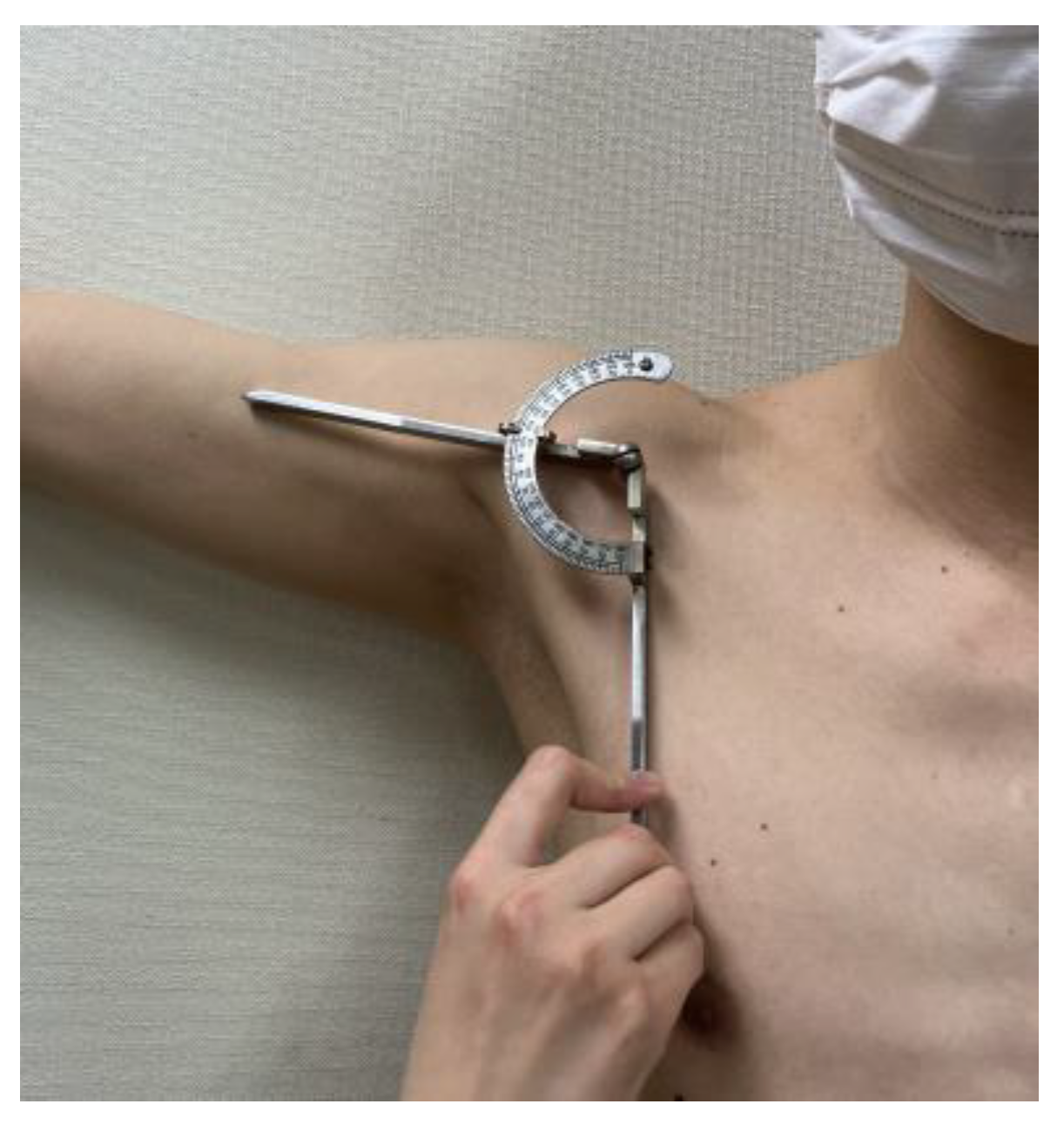
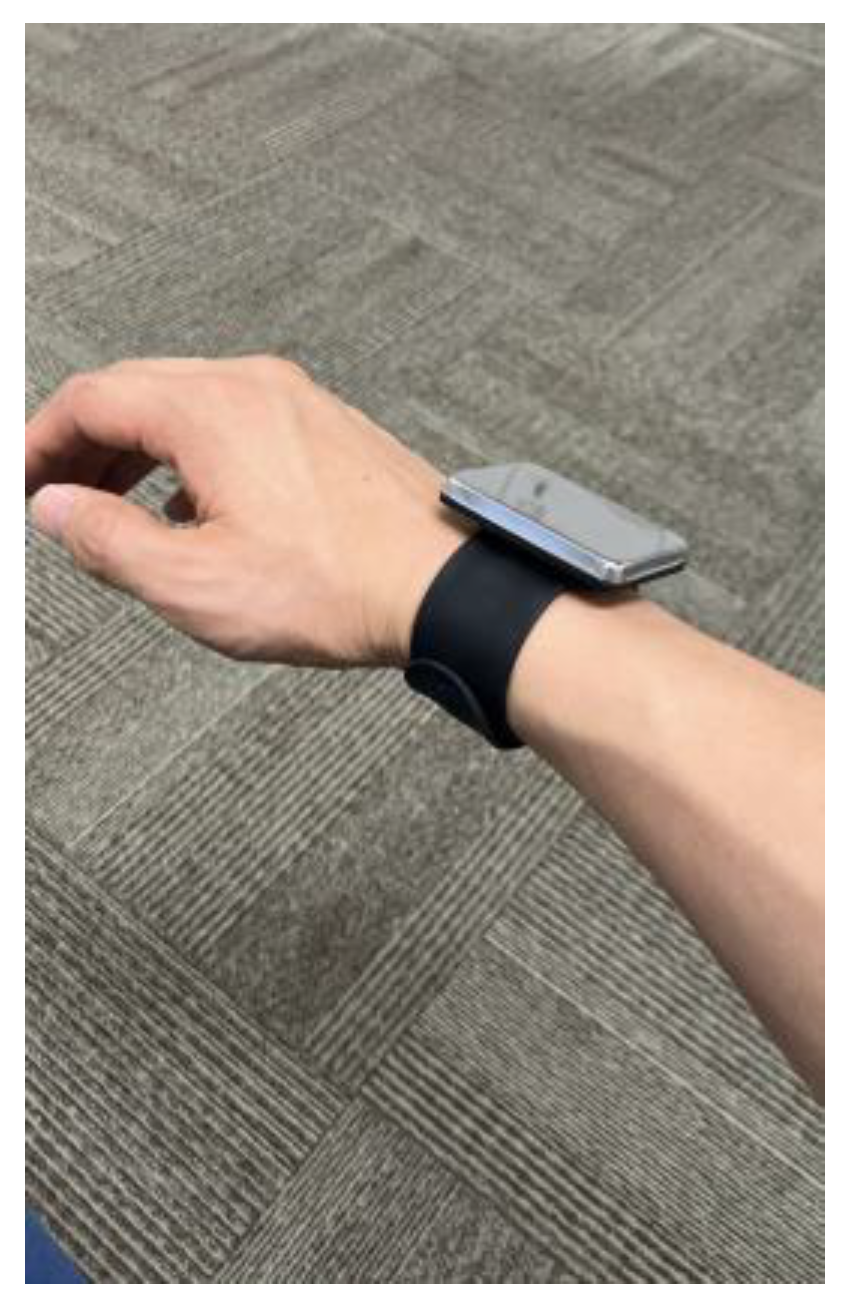
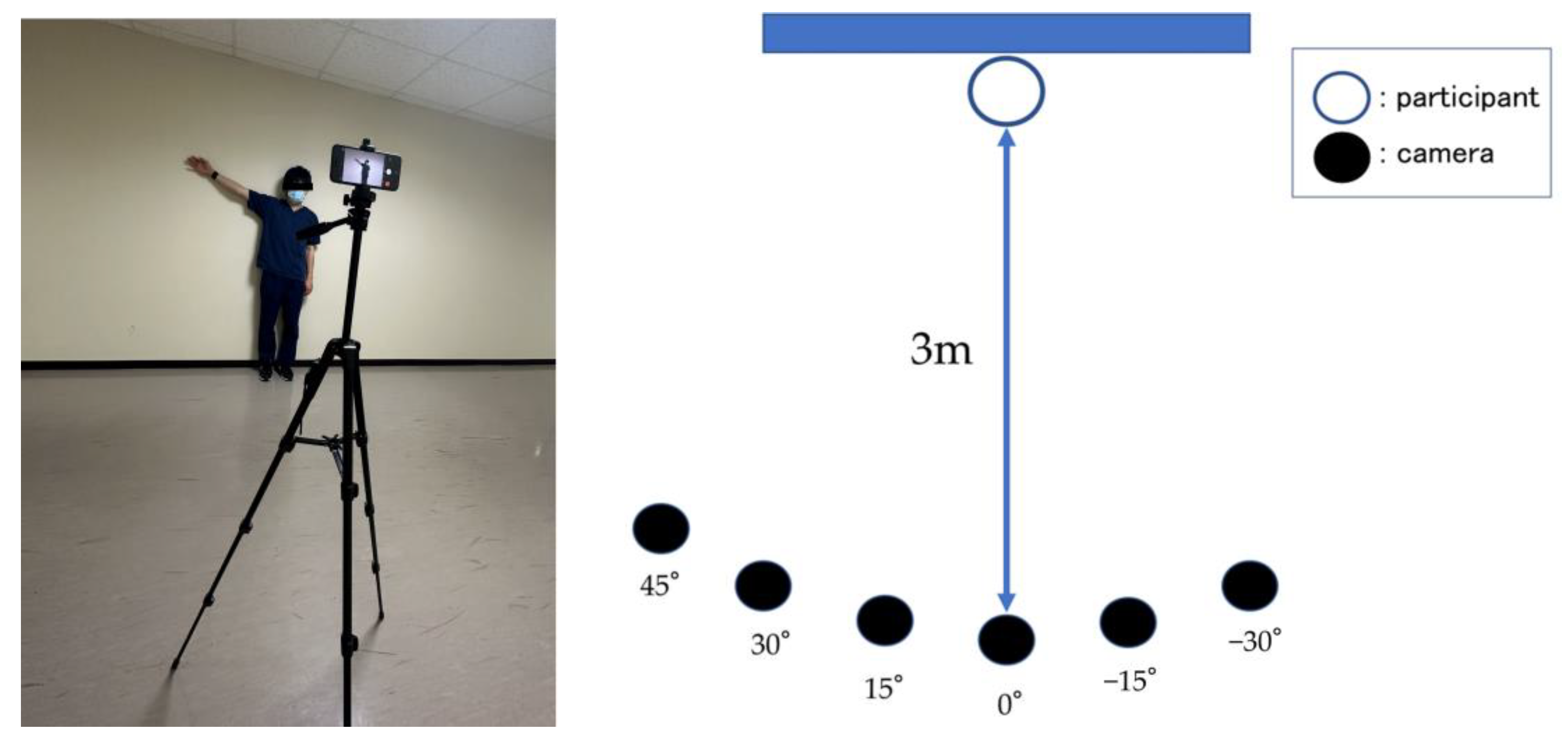
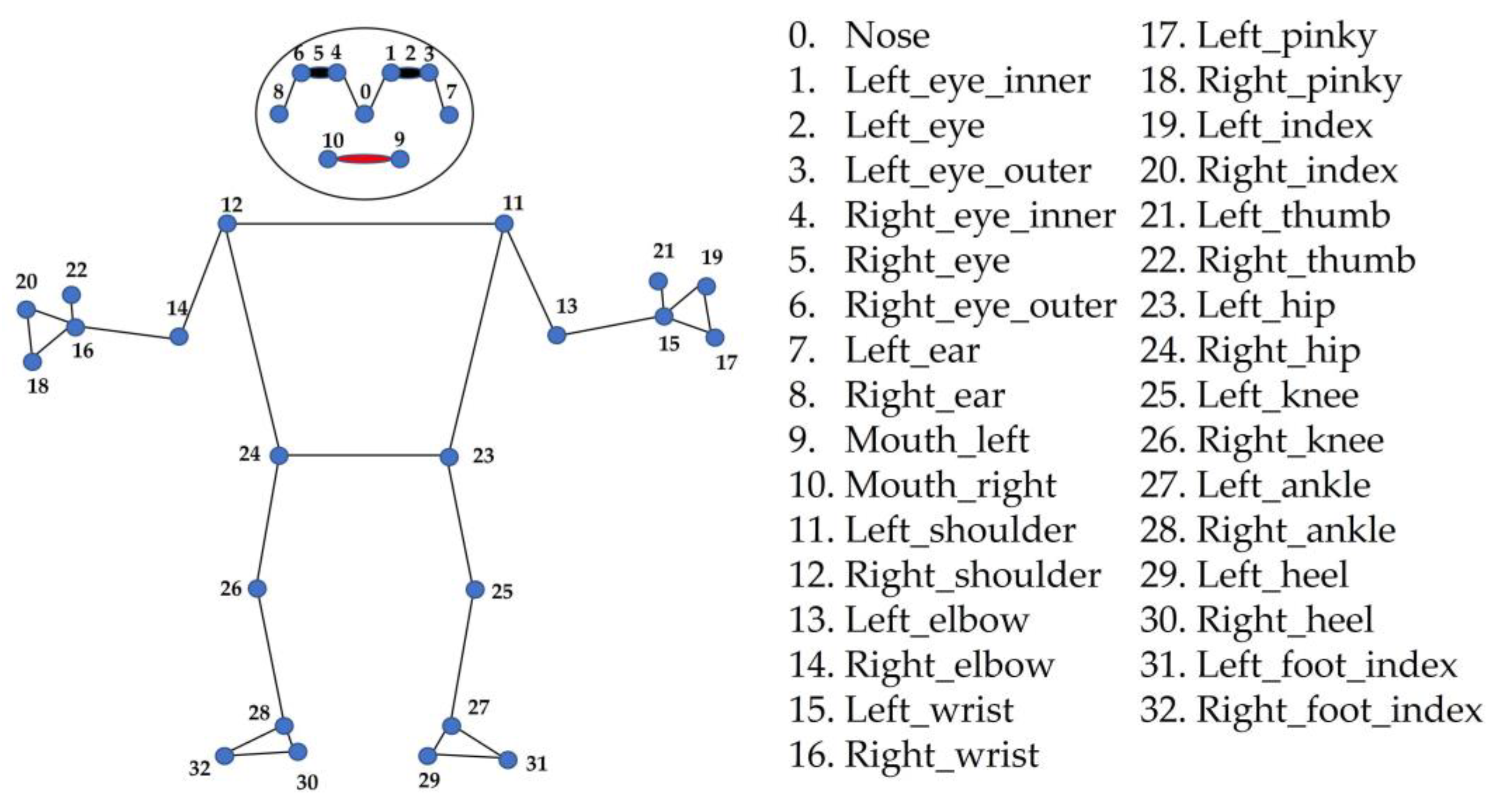
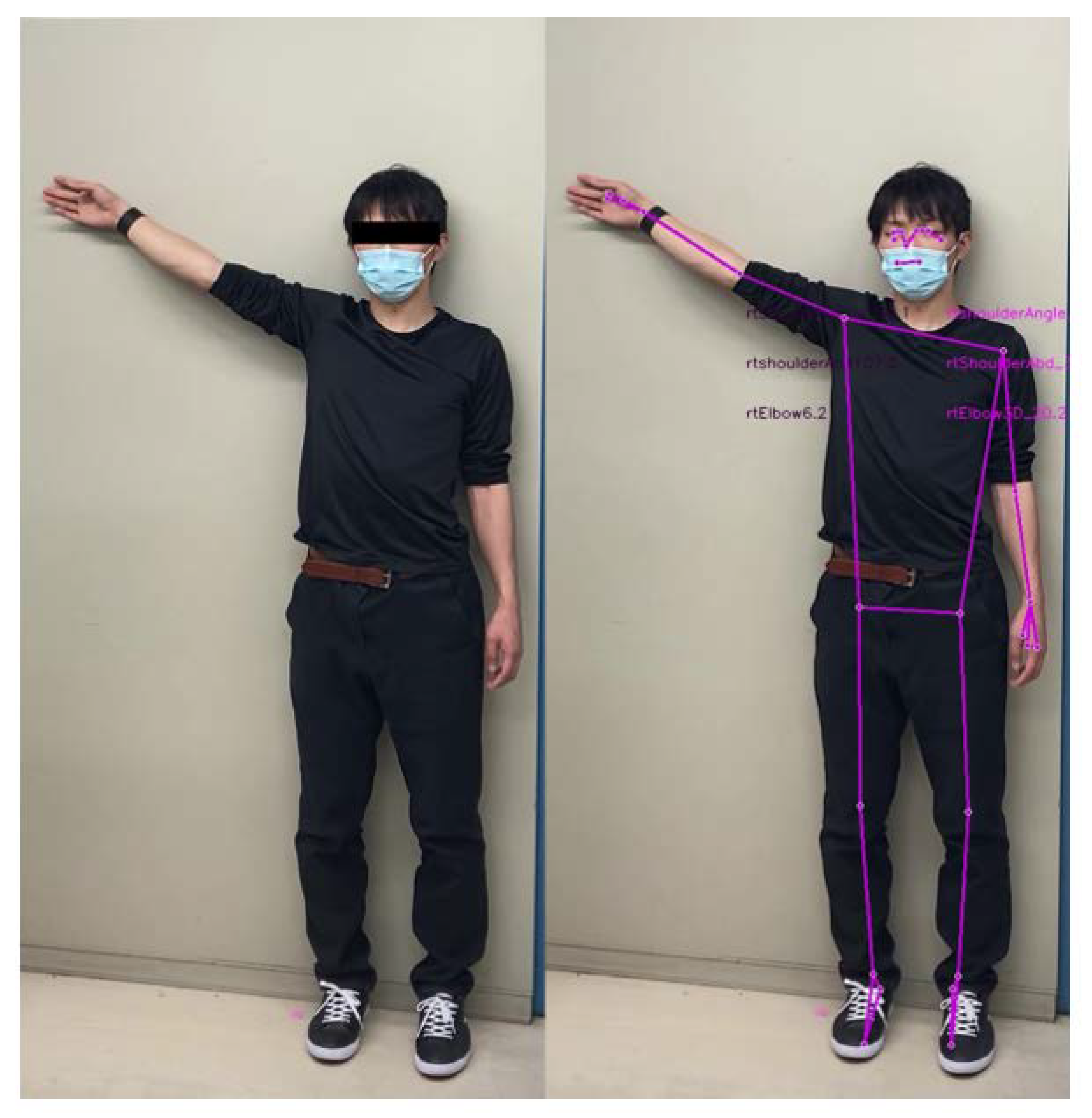
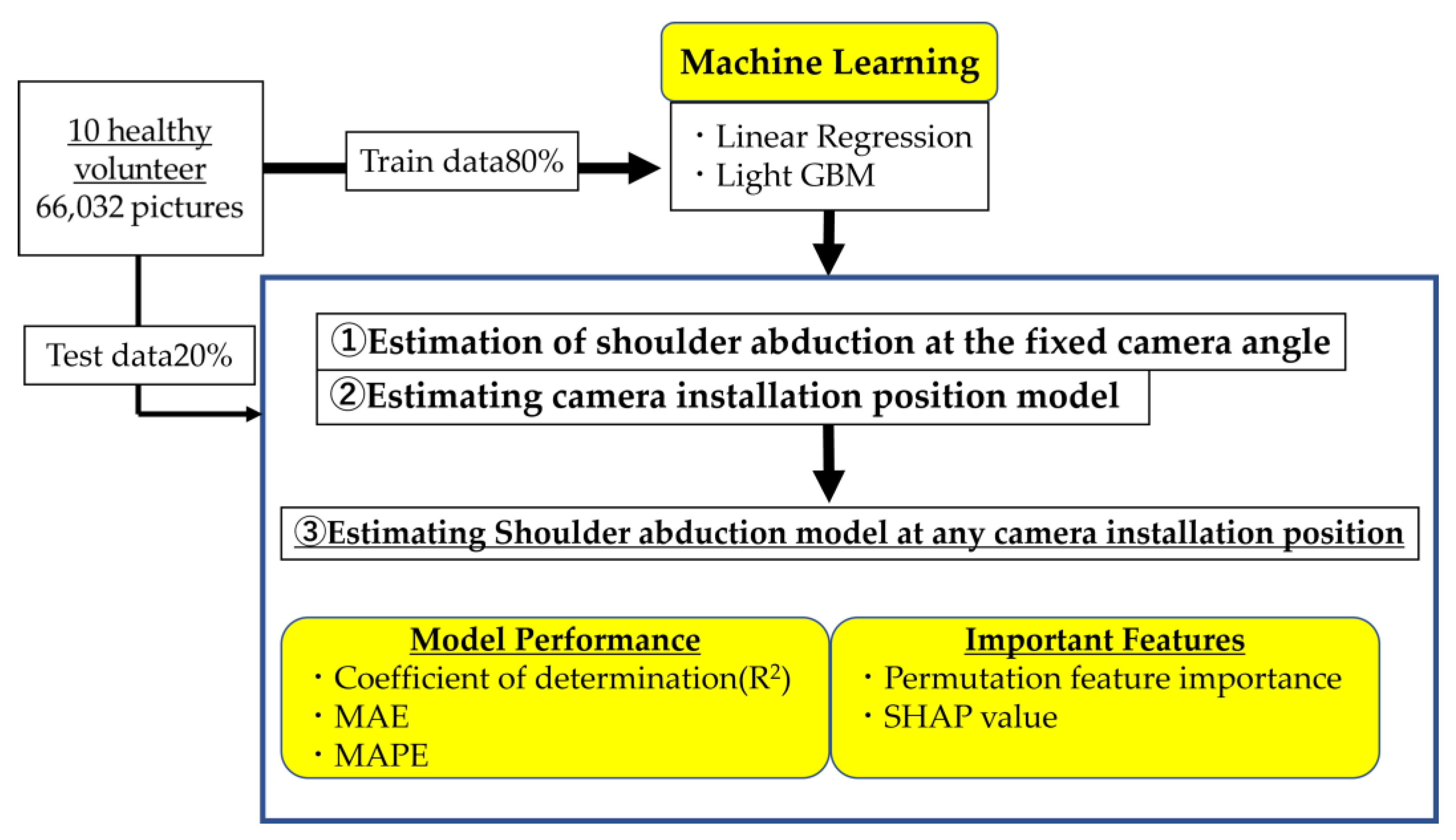
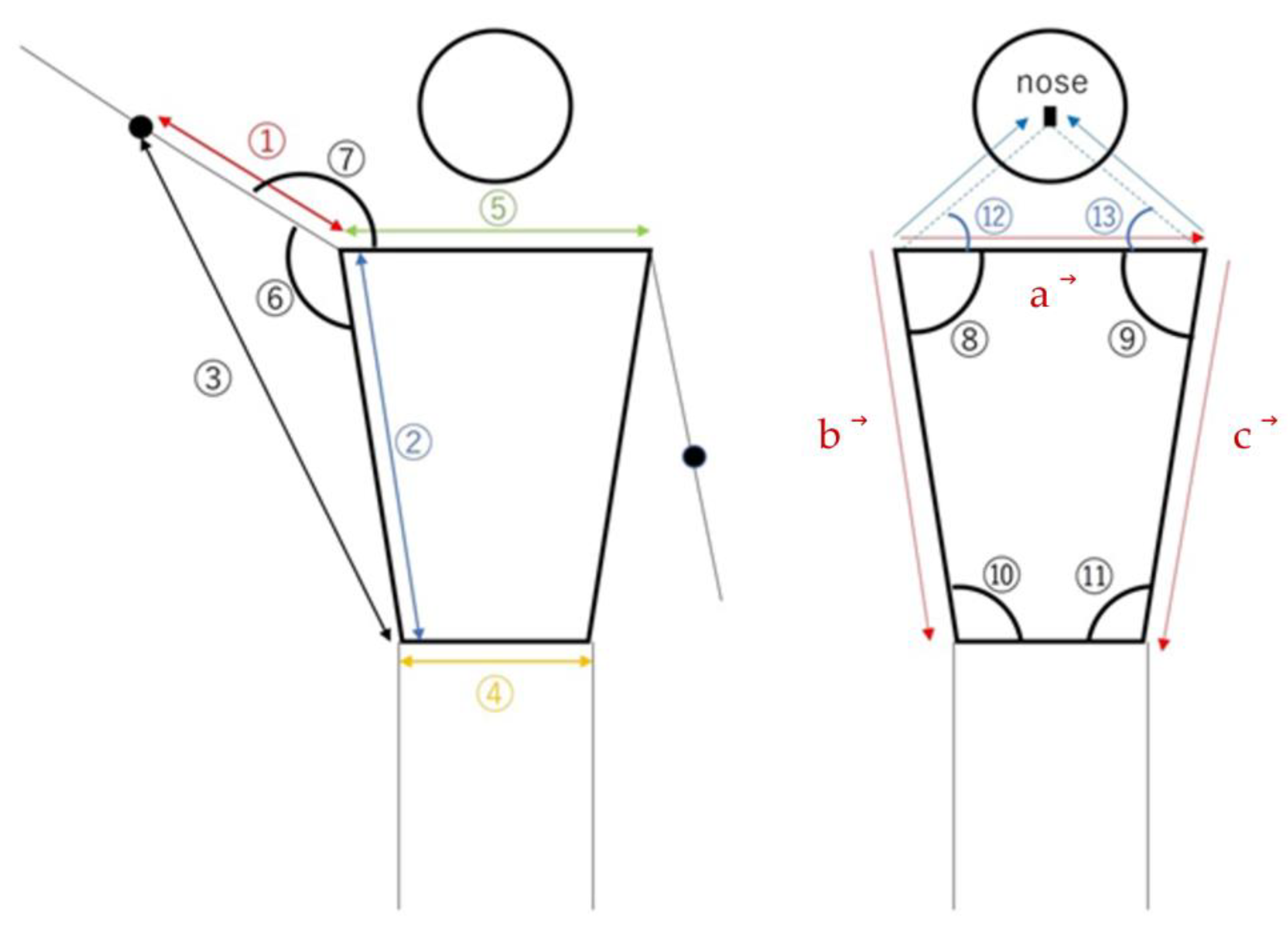
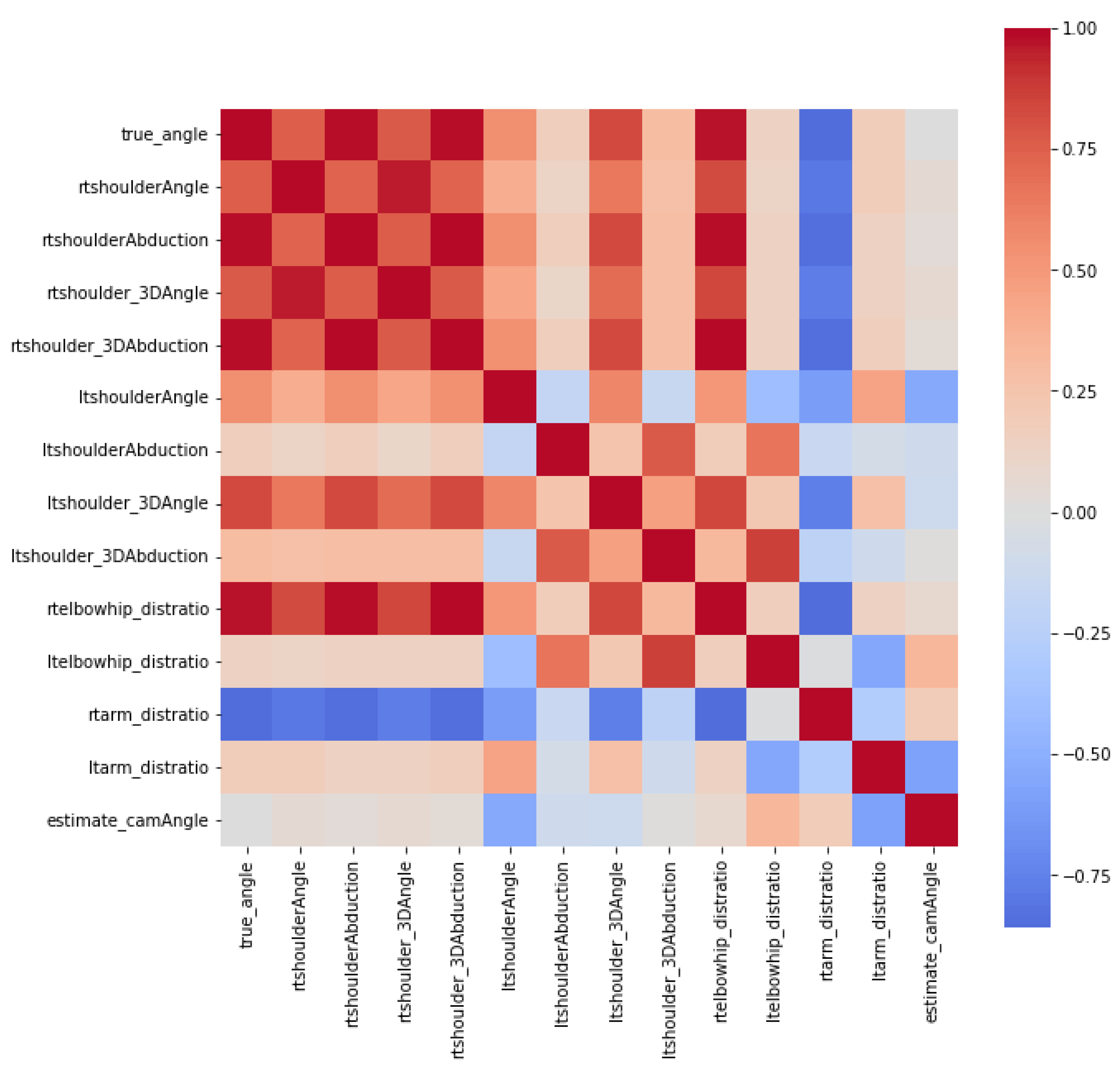
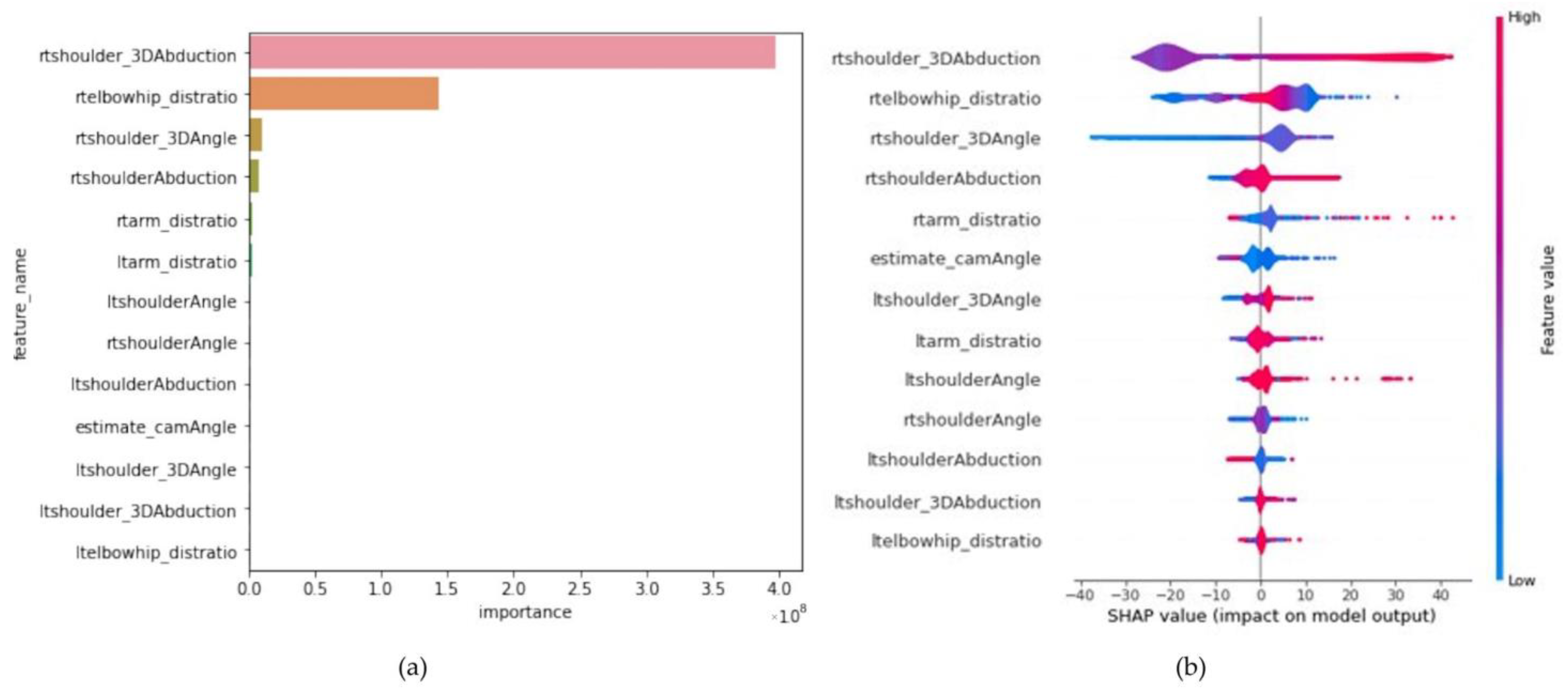
| Estimation of Shoulder Abduction at Fixed Camera Position | Estimation of Camera Installation Position Model | Estimaton of Shoulder Abduction Model at Any Camera Installation Position |
|---|---|---|
| arm_distratio ①/② | hip_distraio ④/② | arm_distratio ①/② |
| elbowhip_distratio ③/② | uppertrunkAngle ⑧, ⑨ | elbowhip_distratio ③/② |
| hip_distraio ④/② | lowertrunkAngle ⑩, ⑪ | shoulderAbduction ⑥ |
| shoulder_distraio ⑤/② | faceAngle ⑫, ⑬ | shoulder_3Dabduction ⑥ |
| shoulderAbduction ⑥ | trunksize | shoulderAngle ⑦ |
| shoulder_3Dabduction ⑥ | shoulder_3Dangle ⑦ | |
| shoulderAngle ⑦ | estimate_camAngle | |
| shoulder_3Dangle ⑦ |
| Camera Angle (°) | ||||||
|---|---|---|---|---|---|---|
| −30 | −15 | 0 | 15 | 30 | 45 | |
| Linear regression | ||||||
| correlation coefficient | 0.993 | 0.991 | 0.992 | 0.998 | 0.996 | 0.998 |
| R2 | 0.986 | 0.981 | 0.984 | 0.995 | 0.993 | 0.995 |
| MAPE (%) | 12.320 | 11.758 | 9.281 | 6.143 | 9.392 | 10.780 |
| LightGBM | ||||||
| correlation coefficient | 1.000 | 1.000 | 1.000 | 1.000 | 0.999 | 0.999 |
| R2 | 0.999 | 0.999 | 0.999 | 1.000 | 0.998 | 0.998 |
| MAPE (%) | 0.612 | 0.978 | 0.686 | 0.322 | 1.706 | 1.516 |
| Parameter | Correlation Coefficient | p Value |
|---|---|---|
| cam_angle | 0.0100 | <0.01 |
| rtshoulderAngle | 0.748 | <0.01 |
| rtshoulderAbduction | 0.978 | <0.01 |
| rtshoulder_3Dangle | 0.774 | <0.01 |
| rtshoulder_3Dabduction | 0.982 | <0.01 |
| ltshoulderAngle | 0.551 | <0.01 |
| ltshoulderAbduction | 0.170 | <0.01 |
| ltshoulder_3Dangle | 0.839 | <0.01 |
| ltshoulder_3Dabduction | 0.302 | <0.01 |
| rtelbowhip_distratio | 0.977 | <0.01 |
| ltelbowhip_distratio | 0.133 | <0.01 |
| rtarm_distratio | −0.856 | <0.01 |
| ltarm_distratio | 0.175 | <0.01 |
| rtshoulder_distratio | −0.783 | <0.01 |
| ltshoulder_distratio | 0.175 | <0.01 |
| rthip_distratio | −0.860 | <0.01 |
| lthip_distratio | 0.0828 | <0.01 |
Disclaimer/Publisher’s Note: The statements, opinions and data contained in all publications are solely those of the individual author(s) and contributor(s) and not of MDPI and/or the editor(s). MDPI and/or the editor(s) disclaim responsibility for any injury to people or property resulting from any ideas, methods, instructions or products referred to in the content. |
© 2023 by the authors. Licensee MDPI, Basel, Switzerland. This article is an open access article distributed under the terms and conditions of the Creative Commons Attribution (CC BY) license (https://creativecommons.org/licenses/by/4.0/).
Share and Cite
Kusunose, M.; Inui, A.; Nishimoto, H.; Mifune, Y.; Yoshikawa, T.; Shinohara, I.; Furukawa, T.; Kato, T.; Tanaka, S.; Kuroda, R. Measurement of Shoulder Abduction Angle with Posture Estimation Artificial Intelligence Model. Sensors 2023, 23, 6445. https://doi.org/10.3390/s23146445
Kusunose M, Inui A, Nishimoto H, Mifune Y, Yoshikawa T, Shinohara I, Furukawa T, Kato T, Tanaka S, Kuroda R. Measurement of Shoulder Abduction Angle with Posture Estimation Artificial Intelligence Model. Sensors. 2023; 23(14):6445. https://doi.org/10.3390/s23146445
Chicago/Turabian StyleKusunose, Masaya, Atsuyuki Inui, Hanako Nishimoto, Yutaka Mifune, Tomoya Yoshikawa, Issei Shinohara, Takahiro Furukawa, Tatsuo Kato, Shuya Tanaka, and Ryosuke Kuroda. 2023. "Measurement of Shoulder Abduction Angle with Posture Estimation Artificial Intelligence Model" Sensors 23, no. 14: 6445. https://doi.org/10.3390/s23146445
APA StyleKusunose, M., Inui, A., Nishimoto, H., Mifune, Y., Yoshikawa, T., Shinohara, I., Furukawa, T., Kato, T., Tanaka, S., & Kuroda, R. (2023). Measurement of Shoulder Abduction Angle with Posture Estimation Artificial Intelligence Model. Sensors, 23(14), 6445. https://doi.org/10.3390/s23146445






